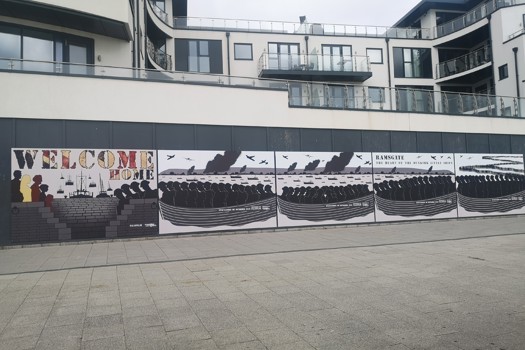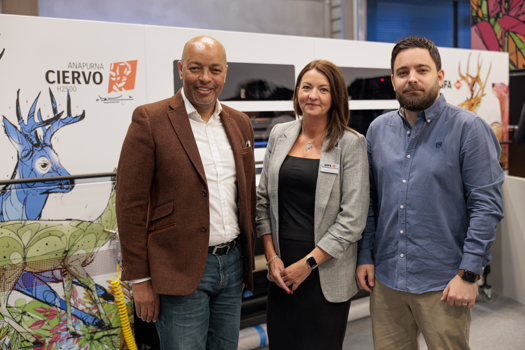One firm that aims to combat the training problem is Statexcolourprint, a Newcastle-based commercial printer. It produces a wide range of work, with clients ranging from global blue-chips to local authorities and universities. Since its creation 13 years ago, directors Graham Minett and Jim Dark have built a £6.5m turnover business that employs 102 members of staff.
Throughout the business’ existence, its ethos has been to continually invest in the latest kit. In the last couple of years alone, £3m has been spent and not one of the firm’s armoury of presses is more than three years old.
Continual reinvestment and growth meant that productivity fell as staff were constantly having to familiarise themselves with new equipment and, in addition, the firm was struggling to find suitable candidates to fuel its ambitious expansion plans.
“Job applicants were coming to us saying ‘I’ve run this press and that press’, and they had really good references,” says Minett. “But we would take them on, on a trial basis, and find that they made expensive mistakes, so in the end we had to say ‘sorry, you’re not for us’.” The high level of staff turnover was also problematic for Statex, with internal resources stretched to recruit and induct new staff, only to find them leaving after a short period.
Both Minett and Dark are time-served apprentices, and Dark believes that the current skills shortage can be traced back to the 1980s where he feels there was a decade-long “black hole” during which nobody was trained. “The unions were very strong at the time and the cost of apprenticeships was astronomical, so it died out,” he says.
This training gap gave rise to a whole generation of printers “who were fine when things were running smoothly, but as soon as they encountered a problem they lacked the knowledge to put it right,” Dark says. Minett and Dark feared that unless this skills shortfall was addressed in their own firm, it could eventually have a negative impact on the business. “We’ve always had a reputation for high-quality work and we needed to find a way to secure that reputation,” says Minett.
As a response, Minett and Dark created an extensive training programme for all members of staff, no matter how senior. This was formalised seven years ago with the appointment of Sue Maitland as finance and HR director. Maitland’s first task was to find funding, and after much digging she managed to get grants from the Tyne and Wear branch of Business Link and the National NVQ Fund.
Every member of staff had a personal training development programme and individuals were encouraged to identify training opportunities that they would like to pursue on both professional and personal levels. This included a wide range of different courses from NVQs through to marketing degrees.
On-site opportunities
In addition to educational qualifications, Statex also snapped up offers of equipment-based training from suppliers such as Graphic Arts Equipment and Heidelberg, and appointed an MIS expert to visit every couple of months to advise people on how they might use the system better.
Everyone in the firm has now had some training. Statex’s aim is eventually to have all staff trained and qualified to a minimum of NVQ Level II. The company achieved the Investors in People standard in 2004.
The firm’s achievements have been recognised through a number of different awards including the Learning, Training and Skills award at the North East Business Awards, plus winner of the PrintWeek Best Customer Service award in 2006 and Best Training Programme, Best Young Printer and a Highly Commended in the same category, at the Printing World Awards 2006. “For a relatively small company going up against big firms with big HR and training departments it was nice to receive the recognition,” says Maitland.
Success stories
The scheme has produced some great success stories: Maitland’s own son Alistair started out cleaning the factory as a summer job before getting gripped by the print bug and taking an NVQ. He now operates a five-colour press and was the recipient of this magazine’s Best Young Printer award last year. Pressroom manager Paul Treanor started out as the firm’s van driver. And then there’s warehouse assistant Maureen Hull who recently achieved her first qualification – an NVQ in computer studies – at the age of 50.
Members of staff now regularly ask the directors for more training. Minett was recently approached by a staff member who wanted to go on a two-year die-making course. The function is currently outsourced but the firm is considering the request because it makes commercial sense to bring it inhouse.
Statex’s attitude towards training isn’t that surprising when you consider its uniquely refreshing approach to employment. For instance, many members of its staff include long-term unemployed who left school with no qualifications. There’s also no barrier in terms of age.
While Statex has been successful with its training programme, Maitland bemoans the difficulties in trying to get information about the available grants and confesses that she only recently found out that the firm’s press minders could get an NVQ. “I knew that there was a scheme in place but I wasn’t sure what it specifically did and who it was targeted at,” she explains. Another gripe Maitland has is the difficulty in securing training grants for over 25-year-olds.
As to whether or not its approach to training has been worth the effort, Minett is in no doubt. “The people who have finished NVQs are now an asset because what they produce 99% of the time is to the highest level,” he explains.
But what about that age-old printer’s lament about ‘why train them up when they’ll only go to a rival firm as soon as a better offer comes along’? In Statex’s experience, the opposite has been the case. Minett feels that training has aided the firm’s high staff retention levels. “We’ve only lost two people in the last seven years,” he says. “That’s a big change from our previous staff turnover levels.”
“Inevitably people want to leave sometimes. But for the long-term future of our business and the industry, people need to be trained. We have no God-given right to keep them, but by investing in them, hopefully we will be able to keep more staff for longer.”
STATEXCOLOURPRINT FACTFILE
Type of company Commercial printer
Number of staff 102
Turnover £6.5m
Size of premises 20,000 sqm
Problem A lack of skilled operators for the firm’s latest kit
Solution Implemented an across-the-board training programme
INSPECTION LESSONS: BUILDING A BETTER WORKFORCE
1 Finding information about grants is difficult. Statex shopped around and enlisted the aid of Business Link and the Chamber of Commerce. The key is to pursue every possible avenue
2 Most of the leading manufacturers and suppliers offer training and sometimes it’s free
3 Retraining is almost as important as training. Often people get into bad habits so it’s a good idea to do refresher courses
4 Don’t fall for the old myth of ‘train them and you’ll lose them’. For the sake of your own business and the printing industry there needs to be a major uplift in skills across the board
5 Investing in your staff and giving them skills and the chance to progress sends a strong message that improves staff retention. This boosts company image, minimises HR issues, cuts down on customer complaints and makes the business more efficient
Better print from better people
While printers are accustomed to the idea that they must constantly invest in order to survive, they are less amenable to the idea that a thriving print operation cant rely on technology alone. Print may be served by technology but its driven by people, and investment in staff is becoming more widely recognised as a crucial underpinning of any technology investment. But print is over-reliant on an ageing workforce and faces a major skills shortage; training has taken a back seat thanks to deteriorating trading conditions over the last two decades.







